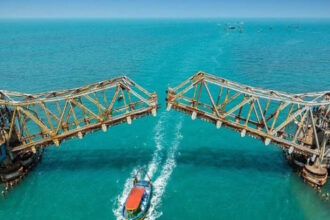The National High-Speed Rail Corporation Limited (NHSRCL) has announced a significant milestone in the ongoing Mumbai-Ahmedabad bullet train project, with the completion of 304 kilometers of viaduct and 388 kilometers of pier construction. This progress marks a major step forward in India’s first high-speed rail corridor, which aims to revolutionize intercity travel with cutting-edge infrastructure and world-class rail technology.
The Mumbai-Ahmedabad High-Speed Rail (MAHSR) corridor, spanning approximately 508 kilometers, will connect Maharashtra and Gujarat with trains capable of speeds up to 320 km/h, drastically reducing travel time between the two cities to under three hours. The project, being executed with technical and financial assistance from Japan, is one of the most ambitious infrastructure endeavors currently underway in the country.
According to NHSRCL officials, the civil construction work has gained considerable momentum in recent months. The completed 304 km viaduct includes several key segments across Gujarat, with work steadily progressing in Maharashtra following the resolution of earlier land acquisition and environmental clearance challenges. The 388 km of completed piers—vertical support structures critical to the elevated track—underscore the engineering scale and complexity of the project.
The viaducts will support a majority of the bullet train’s elevated route, enabling uninterrupted travel across rivers, highways, and urban settlements. NHSRCL also highlighted that major bridge construction, tunnel boring (including India’s first undersea tunnel between Mumbai and Thane), and station development activities are advancing in parallel. So far, construction contracts for nearly 100% of the corridor have been awarded, with advanced precast technologies being deployed to accelerate work while ensuring safety and quality. Dedicated high-speed rail stations are being developed in cities including Surat, Vadodara, Anand, Ahmedabad, Vapi, and Sabarmati, each designed to offer seamless multi-modal connectivity.
Once operational, the Mumbai-Ahmedabad bullet train will not only transform intercity transportation but also set a precedent for future high-speed rail projects in India, such as the proposed corridors from Delhi to Varanasi and from Mumbai to Nagpur. Beyond passenger convenience, the project is also expected to catalyze regional development, create thousands of jobs, and spur investments in surrounding industrial and commercial zones.
Despite initial delays due to land acquisition and the pandemic, NHSRCL is optimistic about meeting revised timelines, with trial runs likely to begin on priority sections by 2026, and full corridor operations expected thereafter. The successful execution of the viaduct and pier construction demonstrates the project’s growing momentum and India’s advancing capabilities in building large-scale high-speed rail infrastructure.











